The unforeseen consequences of our GR 11 Summer walk
I knew walking all
over the Pyrenees during a whole month would come with some side
effects. I could imagine having a few muscular issues in my legs and some
back pain for a while after getting back; after all we did over 7 hours of
exercise every single day during a month. What I got after our hike was
totally unexpected...
I should have run a half marathon in Gandia on the 21st, and instead I
stayed at home doing some assignments. When we came back, I was in a
really good condition, and wanted to keep the good shape we had built the
month before. Given I haven't been able to swim for nearly a year now,
due to the Mysterious Shoulder Injury™ and I don't have enough time to go
out cycling regularly, I centered my efforts in running, with the idea of
starting to get prepared for cross/mountain races this season.
Training had to wait a little because some days after getting back, I
got a sudden pain on both knees, which even made climbing stairs
difficult. It stuck for a while, and when it finally went away, more or
less, I went ahead and tried going out for a run. I haven't been training
for over two years, so I indended to increase the distances
proggressively. The first day I went out, I ran really nicely for the
first 25 minutes, and suddenly I started getting an intense pain in the
outer side of my right knee, to the point I could barely walk back
home.
I've tried letting them rest for weeks, and every time I try them, the
pain comes back. My physiotherapist says my body has developed quite a few
asymmetries, probably caused by the many days I had to walk crippled by a
big blister in my right foot. As time passes, I feel I'm losing all the
physical improvements I had developed during the summer, and I can't do
anything about it.
The new approach to tackle this is yoga. I know my body isn't too
elastic, and the lack of stretching during the walk made it even worse, so
I'll try to forget about “real” traning during some time and focus on
healing my muscles. Hopefully, this will help me resolve the nastiest
physical problem I've ever come across.
23:47 |
[triathlon] |
# |
(comments: 7)
Recipe Manager meets arròs a banda
Two weeks ago, nekohayo posted
a blog entry
on Recipe Manager,
a (you guessed it) cooking recipe manager for GNOME. Looking good, I fetched
the bzr tree from Launchpad and played a bit with it, and soon discovered
it had no internationalisation support.
I've tried to add i18n properly, but I've not had enough time to do it.
Before tackling that, the authors need to give it some bootstrapping love
so the app can actually install, look for its files in /usr/share,
etc.
My fugly, unpostable current patch does allow for a preview of how
Recipe Manager will teach the world about the best rice dish ever, arròs a
banda. Yum!
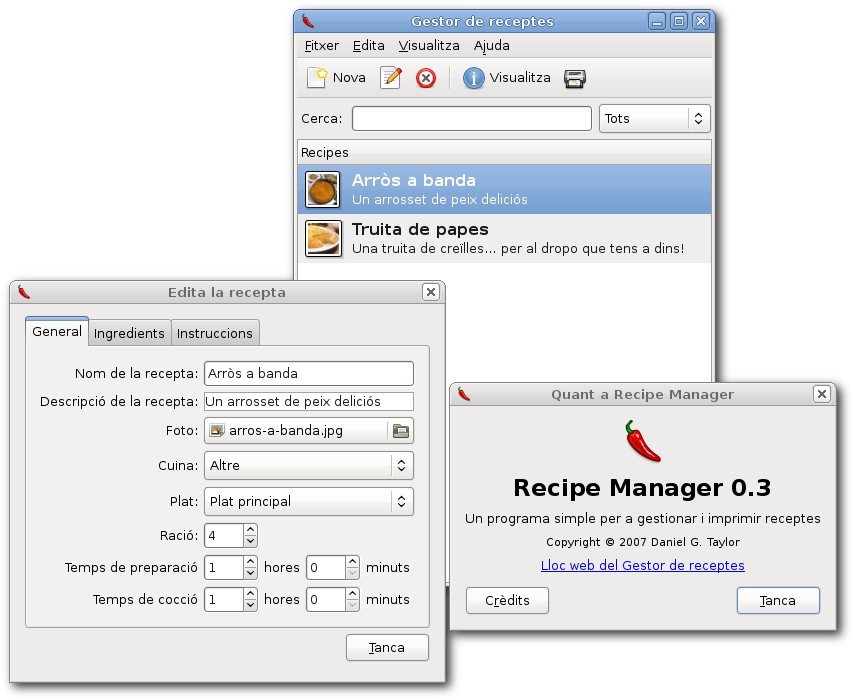
Recipe Manager, showing off the zenith of Valencian culture
00:12 |
[freesoftware] |
# |
(comments: 4)
GNOME 2.32
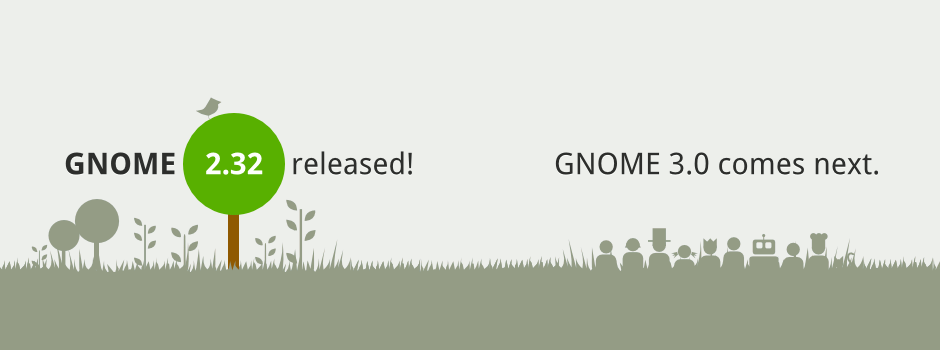
Once again, the GNOME project has
released a major release on time, to the day. Congrats!
While it doesn't feel like a major release, due to the pushing back
of GNOME 3.0 another 6 months in the middle of the cycle and the limited
changes included, I believe it'll be a good one because it just adds on top
of the really solid GNOME 2.30.
GNOME 2.32 is out a bit too late for Debian squeeze, but the
Debian GNOME team has a plan™ to incorporate new 2.32 versions for modules
which don't include big, intrussive changes like migrations to
dconf, or any other dependency on the new versions of
GTK or GLib. The result is that Debian 6.0 will ship with most of GNOME
2.30, plus some cherrypicked new versions of 2.32 modules.
23:49 |
[freesoftware] |
# |
(comments: 2)
De mar a mar, hiking across the Pyrenees
Two weeks ago, Maria and I completed
one of our dreams
when we arrived in Cap de Creus, where the Pyrenean range sinks in the
Mediterranean. To get there, we walked hundreds of kilometres during a month,
crossed dozens of steep valleys and enjoyed one of the richest experiences
of our lives.
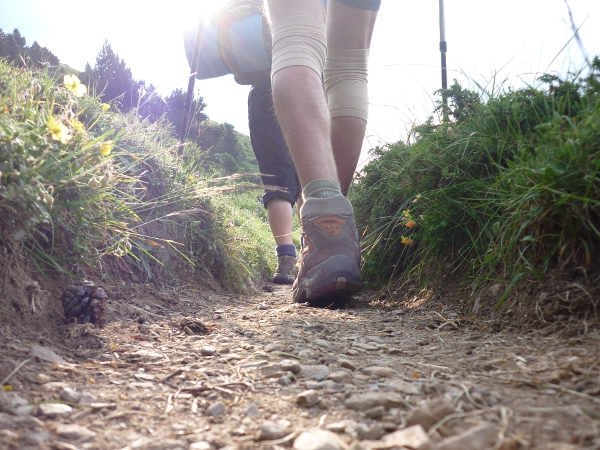
We managed to complete this challenge without facing major problems or
pains, and after the first five our six days, our legs seemed to have
gotten used to the daily effort and it started to be easier and easier.
Our morale kept growing as days passed and we advanced east. When I
started walking on a cold and rainy morning in Hondarribia, after barely
no rest in the night bus to Irún, I thought for myself that it was
improbable that we'd manage to get anywhere near Catalunya, that one of
us would get injuried way before, or we'd just give up and go for the easy
beach vacation in the Basque Country.
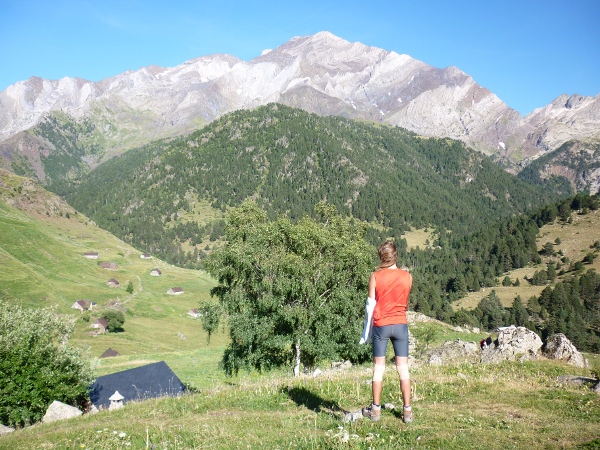
Biadós refuge, under Posets
But we didn't, and after a somewhat painful start, with our boots soaking
wet during the stages that crossed the enchanting Selva de Irati
which ended up with me getting the biggest blister I've ever seen, we
started to walk farther every day, extending the stages when we
felt strong after reaching their official end. When we crossed from
Nafarroa to Aragonese territory, the mental wall that I had built over the
toughest stages in our quest started to fall apart. Days later, we found
ourselves climbing down to Pineta, leaving Ordesa behind and enjoying a
feeling that our adventure could not go better. The weather had been
perfect for over a week and our legs and back were strong to go all over
the way to the sea.
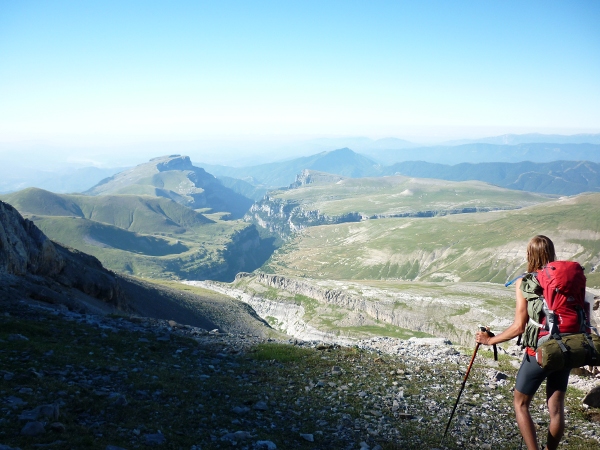
Cañón de Añisclo, on our way to Pineta
When we finally saw that huge blue stain on the horizon, the day before
getting to the last mark, we got really excited. We had made it, but as we
walked towards the cape, happiness slowly got mixed with melancholy. An
unforgettable adventure was about to end, and we didn't want to face our
return to the city and our routines. It had been many days surrounded only by
awesome landscapes, and living without watches, with only sunlight and
weariness marking the time to get in our sleeping bags.
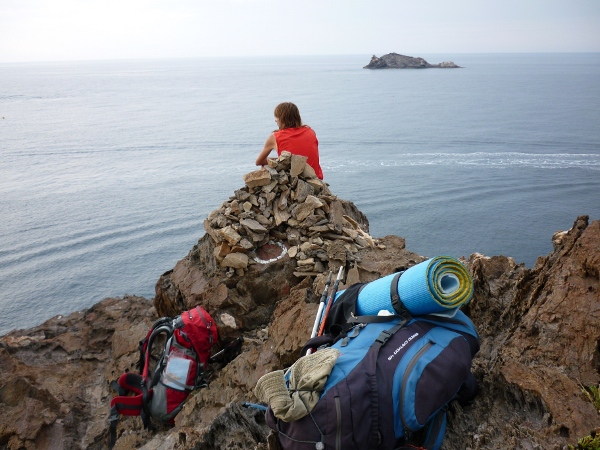
At the very last red and white mark of our journey
We've had plenty of time to meet great people. Starting with
the Navarrian brothers we met in the early stage, which provided us with a
good pace to follow while our leg muscles were still building up; or Kike
and Ana, who drove from Pamplona to visit us during the first Aragonese
stages (thanks for the supplies!). Tomàs and Roger, young hikers from
Mataró, surprised us with their maturity and experience as mountaineers;
we had the pleasure to join forces during four days, walking a really cool
variant through the Infiernos and Collado del Letrero
which avoided going through the ghost city of Panticosa. Roger and Tomàs,
we really hope to meet you soon! Andreu, Manel, Ghandi and Gaŀla visited us
at the Vall de Núria and were unlucky to suffer a frightening
hail and thunder storm when they left our shelter on their way back to
their car. Thanks! All of you have been a very special part of our
experience!
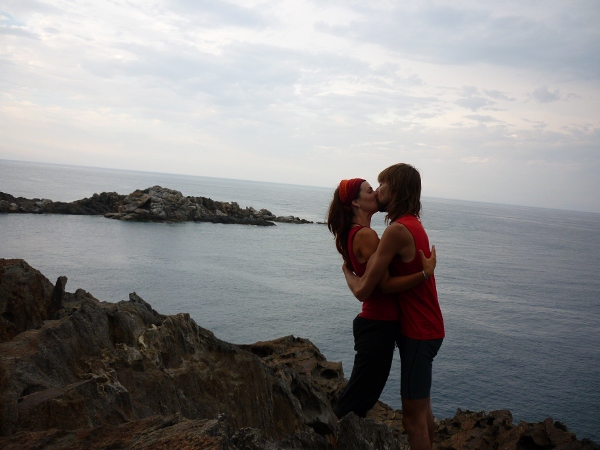
This adventure through GR 11 has been incredibly positive for us for
several reasons. We've learned a lot about ourselves and strengthened our
relation, and now I know how powerful drive can be; to get somewhere, no
matter how far, it's really easy if you just believe you can do it and
desire to get there.
Maria and I are proud of what we've done, and no wonder we're looking
for new challenges. An obvious one would be repeating this experience,
going through the French side of the Pyrenees, but for now, the Corsican
GR 20 seems the most appealing. We'll see, next summer!
23:40 |
[travel] |
# |
(comments: 7)
Hiking through the Pyrenean GR 11
Tomorrow, at this time, I'll probably be unsuccessfully trying to find a
comfortable position on a seat of the Bilmanbus to Irun. Very early
on Saturday, as soon as we get off the bus, Maria and I will quickly head to
Hondarribia's beach in Cape Higer to symbolically wet our feet in the waters
of the Cantabrian Sea.
We won't have much time to enjoy the cold waters of the ocean, though.
Soon after that, we'll have to take a deep breath, look East, and start
walking if we want to achieve our utmost objective: take a bath in the
beautiful beaches of the Cap de Creus, in the Mediterranean sea. In between,
30 days and 840 kilometres of thick woods, deep valleys, high peaks and cold
waters, all of which shape incredible landscapes.
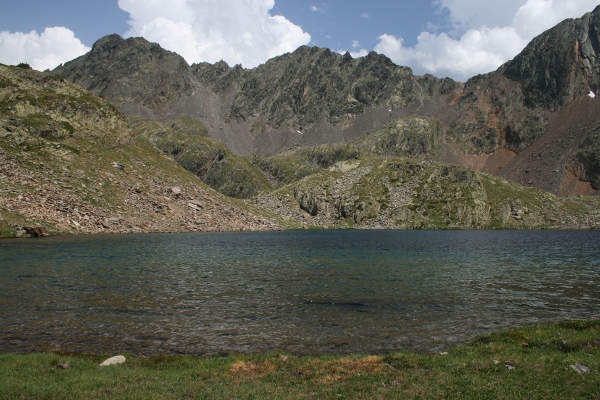
The Portella de Baiau, during our 2008 trip
For a whole month, we'll be mostly disconnected from everything else that
isn't our knee ache, our blisters, the Sun over our heads or where to get
food. It's the first time I leave on a hiking trip as long and tough as this
one, and I feel both uncertainty and eagerness. We've been so busy during the
last few months that we've been unable to train at all for this, and I'm
probably in the worst physical condition in a decade. It's too late
to take care of that now, so we'll try to take good care of our legs and
spine.
In order to get back home in the Mediterranean, we'll have to
be fast, some days joining two stages and skipping a few that we know are not
that interesting (sections over asphalt, etc.). It's hard to make it in just
one month, but we'll try our best. The plan is going to sleep not long after sunset, getting up at dawn, to be able to walk for a decent time before the heat
starts being a handicap and just resting at midday, when the Sun is
strongest.
Of course, this means that I'm missing, yet again, this year's edition
of DebConf in New York City, which is
really sad because I was looking forward hanging around with
Mako,
Mika,
Biella, micah,
Clint and the rest of the
NYC/
Boston gang, but when
the idea of doing a long trip this summer popped up around January, it was
clear DebConf seemed unlikely this year. I hope all of you have a lot of
fun, and see you in a few weeks!
00:14 |
[travel] |
# |
(comments: 1)
Cinema d'Estiu in Benimaclet 2010
Like other years,
Benimaclet's Neighbour Association
has organized a new cycle of film projections for the neighbours, by the
neighbours, with the intention to get people out of their homes and share
a good time with many others. Like in the other two editions, the selected
films try to deliver a message to the viewers, and this year the topics are
centered about labour and migration social issues. A change in this year's
edition is that there will be one more projection, for a total of 5 films,
every Sunday of July, at 22:00 in the Plaça de Benimaclet.
Last week, we saw El viaje de Teo, a Mexican film describing the
migration dramas going on in the Sonora Desert. This Sunday, we'll see
Arcadia, which will be followed by Recursos humanos,
Hijos de los hombres and La estrategia del caracol.
Before each film, some local artists will perform live for us. Make
yourself a sandwich, bring a chair to Benimaclet and enjoy some good
cinema with your neighbours every Sunday in July!
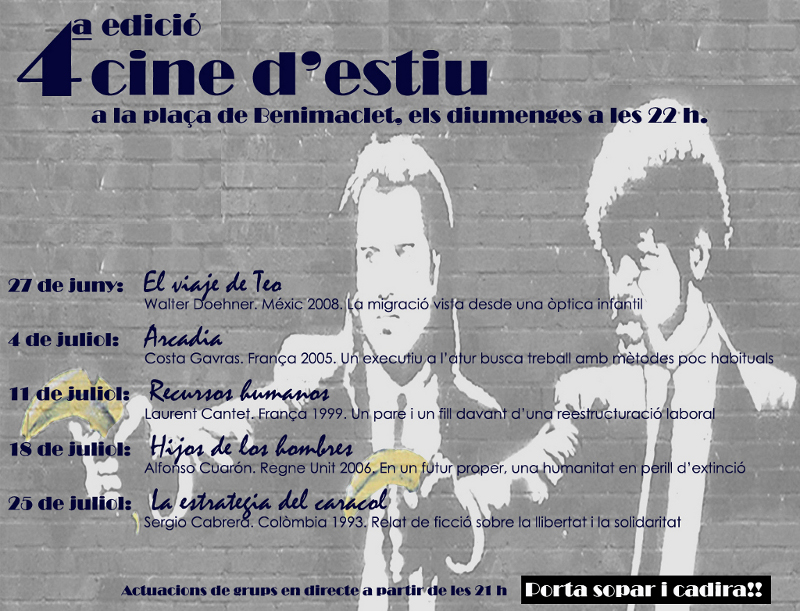
01:31 |
[cinema] |
# |
(comments: 0)
32
On Saturday I turned 32. I haven't been able to sit down for ten minutes and
scribble the “mandatory” blog entry, a sign that I'm extremely busy (luckily
not only due to academic and professional reasons; the social part of the
problem is very significant). This year I was gifted with a costumes
Festa de l'Horta being held on the very same day as my birthday, and
it was memorable (in many ways).
Add an unexpected climbing evening on Friday, and getting to see my
fantastic 2 year old niece Vida, who came from Norwich for a visit, made a
great birthday weekend. I feel I'm going through a very, very sweet
stage of my life; I really can't remember the last time I generally had no
big worries or black clouds all over my head. I hope it stays like this for
a while...
20:33 |
[life] |
# |
(comments: 0)
GNOME 2.30
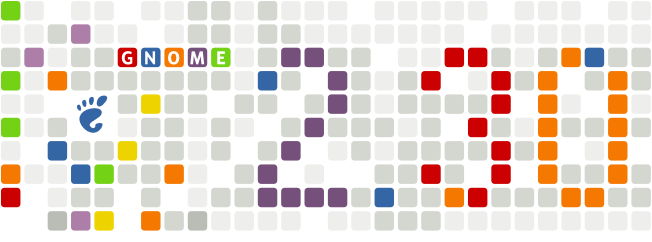
Congratulations to everyone involved in what looks like a very good GNOME
release!
Interesting times are now ahead for the GNOME project, as on the plate is
now a big release like 3.0. That will mean a lot of changes to the desktop
we've got used to in the last decade, and I hope it ends up being successful,
innovative and useful.
Debian has packages for GNOME Shell, and a special
gnome3-session which starts Mutter + Shell. I experimented
with it last week at my work place, and had mixed feelings with the current
status.
I'm not a big fan of hard dependencies on Direct Rendering. My main
computer is an Athlon 800MHz. Compiz crawls on it, and sadly Mutter
is basically unusable on it. At the office, I have P4-based system with 1GB
of RAM, which runs GNOME 2.28 OK. When I switched to the GNOME 3 session, it
showed that it's getting old. I also experienced X crashes and kernel
oopses, apparently a classic for ATI users using a composited window manager.
This being said, I consider myself lucky because both systems have ATI cards
and can do DRI using free software. If I was forced to use nVidia non-free
drivers, it'd probably mean I'd stick with the Panel until that wasn't an
option at all.
I am aware we'll see improvements both in Xorg/kernel and GNOME before
GNOME 3.0 is released next Autumn, and have high hopes for a release that
is accepted by our users really fast (avoiding a KDE 4.0 situation). GNOME
hackers have done good stuff for ages, and 3.0 will be a new example!
23:53 |
[freesoftware] |
# |
(comments: 2)
Tinyproxy 1.8
A while ago, I was asked to recompile
Tinyproxy to enable transparent
proxying support, which was not being compiled in etch's Debian
package. As it tends to happen, once I got the source and looked into
doing a quick rebuild with --enable-transparent-proxy, I noticed
the package was in such a bad shape, that I couldn't just leave it like that,
so I found myself doing
a few more changes,
which mostly involved updating the packaging so it didn't suck a lot, and
splitting the Debian patches so things could be sent upstream or dropped when
new versions appeared.
However, even if Ed had asked me to go ahead and take over the package, this
was meant to be a one-day effort, and soon I had forgotten about Tinyproxy,
except for the ocassional bug mail getting through the PTS. It also didn't
help that Tinyproxy had been pretty much dead upstream for years.
So lately, a few bug reports were reporting a ∗gasp∗ new
major Tinyproxy release, after 7 years of basically nothing. OMG, what do I
see, there's a Git repo! And an upstream Bugzilla! Somehow, feeling I owed
Ed a reply to his unanswered request, I went ahead and tagged tinyproxy
1.6.3-3.2 in collab-maint, and started working on the new version. Adding
myself to Uploaders, and getting rid of the “make no unnecessary changes”
vetto, I rewrote
most of the packaging. And for a change, I looked for and found a #tinyproxy
channel on IRC and told muks and obnox that the days of Tinyproxy's stay in
the Debian/Ubuntu limbo were over.
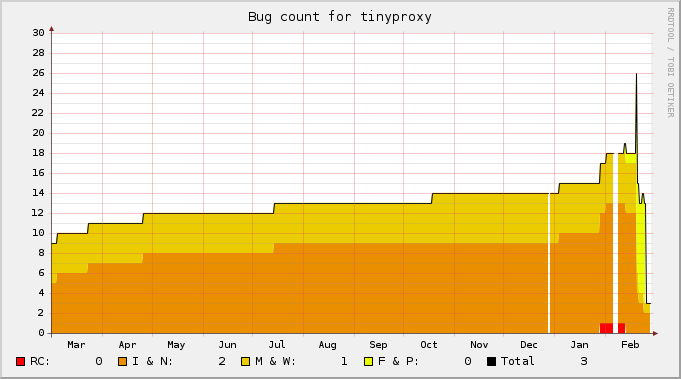
They were happy to get a few bugs and patches forwareded upstream, and
asked me why all of this hadn't happened before. Pitty is that a few
longstanding issues were well known in Debian but not so obvious for the new
upstream maintainers, and are present in 1.8.0. Hopefully all will be
dealt with in 1.8.1 or the next major version. The lesson is: if you work on an
apparently abandoned package, after cleaning the mess in your NMU, try to
spend 15 more minutes trying to contact upstream (if available), pointing
them at the patch tracker and our list of bugs: chances are many are still
useful. Also, contact the Debian maintainer, and if they ask you to take over,
at least post a RFA so someone else can.
If you're a Tinyproxy user, I'd be happy to hear if the current package in
Debian unstable works for you. If you were having weird issues with 1.6.x,
chances are 1.8 will fix them. The package can be installed on stable
with no extra dependencies, so if you're feeling adventurous, go ahead and
upgrade.
23:44 |
[freesoftware] |
# |
(comments: 2)
Cabanyal
Today, I was glad to attend the biggest demonstration ever in favour of the
Cabanyal neighbourhood of València, a traditional district populated by the
sea people of the city. After decades of oblivion, the Valencian right-wing
government is trying to execute an old plan to “open Valencia to the sea”,
which means demolishing around 450 traditional houses, many of them under
protection for their cultural and architectural value, to extend a big avenue
until the beach. Patrimonial loss aside, neighbours would be forced to
other areas in the city (sadly, this has been happening for a decade already),
making Cabanyal-Canyamelar the new posh neighbourhood for the richer class,
destroying its identity and replacing it with a new set of skyscrapers.
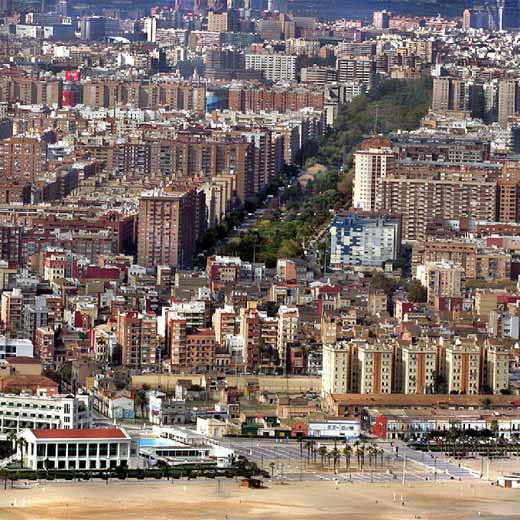
The local government of PP, led by the infamous Rita Barberá, knows that
getting the anti-riot police in the neighbourhood and forcing very old men
and women out of the houses where they were born isn't what many people like to
see in the evening news. They also know time is their ally; this plan is
many decades old, and there's no need to hurry now, so it's better to apply
silent mafia tactics on the problem. It's very easy.
First, stop investing a single euro in the area and monitor the slow but
effective results of the degradation. Have a bit of patience, and after
quite a few years, start promoting the illegal occupation of the increasing
number of empty houses by marginal collectives which will bring the associated
introduction of drug dealing in the area. This will surely make even more
people leave or accelerate their decease. Keep repeating this process, until
the Cabanyal is really fucked up. Now, start promoting the “rehabilitation
plan”, which unavoidably includes splitting the neighbourhood in two
pieces, and destroying a substantial part of it. Hopefully, many of the
neighbours not directly affected by the demolitions will back the plan, they
can't be blamed for being really fed up after all. Do all you can to confront
those in favour to those against. In the meanwhile, start harrassing owners,
make them end up selling their property at ridiculous prices and as soon as
this happens, demolish it very quickly. Don't even bother with cleaning up the
rubble: an increasing number of sites like this all over the place may be
what makes a few more families give up and leave.
In the end, you either have an empty neighbourhood, or you've managed to
demolish all the annoying houses that block your shiny avenue. However, if a
Supreme Court argues that the remaining houses still have some
cultural value, you might want to consider changing your local law to
unprotect those architectural elements.
Today, many thousands of Valencians marched around Cabanyal to say
“enough!”. From the street, I saw several old women out on the balconies
of their beautiful houses, their eyes wet with tears, while they observed in
silence all that many people who were fighting for them. There's still a long
way to go in the courts until this is all over, but at least these people
have a little more hope today than those in el Carme or La Punta, who ended
up losing similar battles, years ago.
23:52 |
[life] |
# |
(comments: 4)
<< Page 2 of 39 >>
















